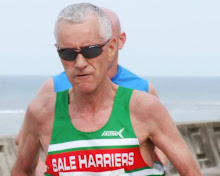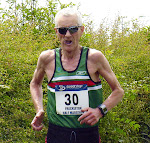I was discussing Kathrine Switzer, the subject of Tuesday's blog post, with my wife Pat this morning. She agreed with the obvious, that there are vast more numbers of ladies road running now from back in the day when she first started accompanying me to races in the early '70s as a spectator. My recollection from those days is that the ladies were only seen running distance over the country but not on track or the road.
Her conclusion was that given a typical race today the numbers of women must equal that of men. Was she right? And just how many women were in those races that she stood and watched?
Given that it wasn't until the Olympics of 1972 that women competed over 1500 metres their involvement is road races was to be expected to be low......but just how low?
Just for interest I looked at some random race results from past just before the '80s "running boom" and recent present.
In 1978, the EAST CHESHIRE 7 (no 10Ks in those days) showed 156 ran, with just 11 vets in the first 100 and no ladies at all. 410 started the 3 Peaks Race that year. 336 finished but there was no ladies race until 1979. The CROXDALE "10" miler won by silver Olympian Mike Mc Leod in 49.17, shows 192 male finishers but curiously they organisers acknowledge that one Norma Campbell of Blaydon harriers ran 69.39 but she is not listed in order in the results!
The following year, the FRECKLETON HALF MARATHON of '78 shows just one lady finisher, with 3 each year in 1979 and 1980. No sign of a boom there then but going further north that year saw 14 ladies climb out of Bowness and head to Kendal in the "Windermere to Kendal 10 mile road race". The results show UK's all time female marathon runner, Veronique Marot, taking 5th spot in 65.05.
Going forward to 1982 and the Lancashire 10 mile race at Clitheroe I was expecting to see a higher percentage of ladies had run. A field of 529 tackled the undulating course
but only 18 women. The winner, A. Tamplin of Harlow, ran an excellent 60.25 but it was good enough for 211 place as 197 men ran inside 60 minutes!
One of the 5 marathons I ran in 1982 was the comparatively low key SANDBACH MARATHON
in Cheshire. 270 men and just 17 ladies ran in "sweltering conditions". The ever improving Ms Marot (unattached) won the ladies race in 2:54.29. Within 3 years she was down to 2:28.04 (Chicago 1985) later going on to run 2:25:56 in the London of 1989. Picture shows her (9) with coach Brian Scobie (80).
If 211 inside the hour for 10 miles looks amazing, the 1983 ROWNTREES YORK 10 MILER
surpasses even that . That memorable day 322 ran under 60 minutes including 2 ladies who were contesting the very first Yorkshire Ladies 10 mile championship. Jill Clarke ran 56.37 and Sheila Catford 58.35. They were joined by 86 others making up 7.47% of the field. My 51.41 was only good enough for 21st place in a race won by Holmfirth stalwart Alwyn Dewhirst in 48.46.
I think we can reasonably conclude that over the last 20 years that percentage has steadily increased. But to what extent?
Looking at 3 recent north 10 mile races the percentage of ladies finishing has increased to an average of
approx. 28% but Pat 's assessment nearly proved spot on in this month's GREAT LANGDALE XMAS PUDDING RUN. The figure of 216 male participants was almost matched by the 211 ladies who ran.
Race organisers note. Give a race souvenir which saves the ladies a bit of time cooking in the kitchen and gives them more time for running!
These "findings" would at first glance contradict Sport England’s latest participation figures which
have been described as disappointing. They revealed a significant drop in the number of young people aged between 16-19 and women "playing sport" due to cost and lack of time through work.
No doubt though the snowy November and December of 2010 had a bearing on figures. However, the study does say that running (along with table table tennis and boxing) is on the up as our
race results show.
In conclusion there is no doubt the high percentage of ladies in all aspects of running now has to be borne in mind by club committees, race organisers and of course suppliers and retailers in the running business.
Indeed ladies today, a running force to be reckoned with and if not quite "on an equal footing" yet soon will be!
Thursday, 15 December 2011
Subscribe to:
Post Comments (Atom)











It was only in 1975 that the relevant Committee of the WAAA passed a rule allowing Women, for a trial period, to run long distance. Additional rules were passed to allow 'ensure effective control and a comprehensive study of results.' I think this was in response to a 10-miler in Kent where some rebels allowed the ladies to start 5 seconds behind the men (so that they weren't in the race you understand).
ReplyDelete